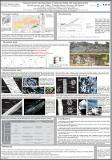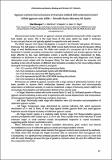Por favor, use este identificador para citar o enlazar a este item:
http://hdl.handle.net/10261/237661COMPARTIR / EXPORTAR:
 SHARE
BASE SHARE
BASE
|
|
| Visualizar otros formatos: MARC | Dublin Core | RDF | ORE | MODS | METS | DIDL | DATACITE | |

| Título: | Gypsum cement microstructures in fractures related with extensional event (Vilobí gypsum unit, Vallès - Penedès Basin, Miocene, NE Spain) |
Autor: | Moragas, Mar CSIC ORCID ; Martínez Rodríguez, Cristina ; Baqués, Vinyet CSIC ORCID; Alías, G.; Playà, E. | Palabras clave: | Gypsum cements Penedes Miocene |
Fecha de publicación: | 31-ago-2011 | Resumen: | Microstructural studies focused on gypsum cements precipitated along faults within evaporite host bodies are scarce. This is the main focus of this work, which has made it necessary to use concepts that are not typically applied to evaporite rocks and cements. The Vilobí Gypsum Unit (Upper Burdigalian) is located in the Penedès half-graben, NE Iberian Peninsula. The half-graben is limited by ENE¿WSW normal faults formed during the Neogene rifting stage of west Mediterranean area. The Vilobí unit consists of a succession up to 60 m thick of laminated to banded secondary (coming from anhydrite hydration) and primary gypsum that has been affected by two main deformation events: a ductile deformation represented by folds, millimetres to decimetres in size, which were produced during the early diagenesis, and a fragile deformation event related with the Neogene rifting. The later event affected the evaporite unit resulting in five sets of fractures of different time formation according to the cross-cutting relation (arranged chronologically from oldest to youngest): - Set 1 (S1) consists of NE-SW trending extensional faults. - Set 2 (S2) comprises a normal faults system with ENE-WSW trending. - Set 3 (S3) formed by subvertical NW-dipping joints. - Set 4 (S4) represented by NE-SW to ENE-WSW trending thrust faults. - Set 5 (S5) comprises a SE-dipping system joints. All fractures are refilled by gypsum cements with a large variety of deformation textures. It has been possible to observe direct relationship between main structures and microscopically observations of deformed samples. It could be established 4 stages of fracturing which reaffirm the chronology of precipitation and deformation defined at the outcrop scale. - 1st Stage: Extensive context with active normal faults (S1 and S2). Antitaxial growths of fibrous gypsum cement indicating a shear sense in agreement with normal displacement, and incorporation of host-gypsum fragments and fish type crystals in shear zone. - 2nd Stage: Tectonically stable stage with dilatation veins (S3) formation and precipitation of millimetre gypsum crystals. - 3rd Stage: Compressive stage determined by outcrop indicators (S4), which represents reactivation of S1 and S2 faults. In that stage appear broken gypsum fibres and small gypsum fragments around irregular boundary of millimetre gypsum crystals. - 4th Stage: Karstic regime in a relatively stable tectonic stage (S5). Megacrystalline gypsum cements precipitation with crystals up to 25 cm in size. These crystals show some indicators of small extensive stages as small oriented crystals (recrystallized) fragments in crystal boundaries, suggesting gentle tectonic reactivation events. Minor deformations such as internal crystalline dislocations, grain contact and internal recrystallizations occur in millimetre gypsum crystals and megacrystalline cement. Sulphur and oxygen isotope values indicate that gypsum cements were produced by sulphatesrich fluids which flow through the fragile structures after an interaction with host-gypsum rock. Consequently, it is significant that antitaxial growth of gypsum fibres in veins occurs in a host-rock with the same lithology, because this type of growth is common where the vein fill is different from the composition host-rock. | Descripción: | Deformation mechanisms, Rheology and Tectonics 2011, 31 agosto- 2 septiembre 2011, Oviedo | URI: | http://hdl.handle.net/10261/237661 |
| Aparece en las colecciones: | (Geo3Bcn) Comunicaciones congresos |
Ficheros en este ítem:
| Fichero | Descripción | Tamaño | Formato | |
|---|---|---|---|---|
| 2011_Moragas_et_al_DRT_Poster.pdf | 6,38 MB | Adobe PDF |  Visualizar/Abrir | |
| 2011_Moragas_et_al_DRT_Abstract.pdf | 62,01 kB | Adobe PDF |  Visualizar/Abrir |
CORE Recommender
Este item está licenciado bajo una Licencia Creative Commons

